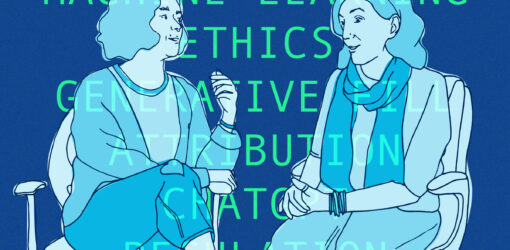
Real Talents talk: Artificial Intelligence
An occasional series featuring two BD team members in conversation about current issues, technologies and practices impacting our work.
Artificial Intelligence (AI) — a term first coined in the 1950s — had breakout year in 2023. In particular, the subfield of Generative AI grew exponentially, and opinions on the implications of using the technology continue dominating discussions about the future of work.
Designer + Manager Riley Brady and Writer + Strategist Genevieve Waller recently explored what AI means for BD.
RILEY
A crucial benefit of weaving Generative AI technology into graphic design is its efficiency. Adding it to the tools we already use is helping streamline prescriptive workflows and enabling our team to focus on thinking creatively. For instance, we were excited to play around with the beta version of Photoshop’s Generative Fill tool — and now we’re saving time by using it to remove and expand stock photography content.
GENEVIEVE
It’s definitely efficient. Compiling data and research can take a while, and using a program like ChatGPT increases the speed at which I can do this. With the time gained, I’m able to shift my focus to analyzing information and giving more attention to fine-tuning insights, strategy and messaging. I like your view that AI is another tool in our skillset, rather than a behemoth that’s going to supersede our expertise. At least for now.
RILEY
Yes, but critics note we humans need to stay aware of the ethical concerns inherent in AI and Machine Learning (ML). The technology is moving much faster than the speed of regulation, and some of the tools accessible to designers could end up causing harm in the name of progress.
GENEVIEVE
I’ve attended several panel discussions and seminars that have explored this topic. What are your top concerns?
RILEY
Human equity and homogenized design. Being aware of bias in image generators can inform how we use AI. It’s well-studied that humans have unconscious biases that show up in myriad ways. Adding to unconscious bias, there’s also a lack of diversity among AI professionals — for instance, globally, only 22% are women, and Black employees comprise just 4% of Silicon Valley’s AI workforce, according to the World Economic Forum and the AI Now Institute.
Both those factors impact the images that are being created and made available for use. For instance, our team is constantly running into the lack of racial diversity in stock photography. I also hesitate to use software built and trained predominantly by a non-diverse group of professionals to help generate images of, for example, people of color in office settings. We’re hoping the field of ML responds — soon and robustly — to call for more diversity, equity and inclusion.
GENEVIEVE
My big concerns are the same as many others who use AI in research and writing —accuracy, attribution and awareness.
By now, people have heard plenty of stories about AI-generated information being completely erroneous, or providing content that blatantly violates copyright laws. At BD, we’re primarily using AI to gather background, rather than in materials we share with clients or for them to share publicly, but those drawbacks are always top of mind. I’m committed to ensuring generated information we’re using is truthful and that we’re not stealing someone else’s work.
RILEY
And “awareness”? What do you mean by that?
GENEVIEVE
AI isn’t self-aware. That’s a very human attribute. When I’m developing strategy and content, I’m always considering who I’m doing it for, why I’m doing it and what our goals are. Having this awareness empowers me to write in a particular voice, provide unique context. We’re still at the point where AI writing is pretty atonal, impersonal and context-deficient. That said, it will be a new discussion when the systems become more “humanized,” so to speak.
RILEY
There’s a similar concern in design. The term “blandification” has been used to express the prevalent concern that AI will turn graphic design into an ocean of sameness and influence creatives to circumvent the act of creativity itself.
I don’t want my design tools to prescribe that the technology brand I’m designing should use shades of blues and grays, a geometric sans serif and futuristic imagery. Because that machine would probably be telling every other designer the same thing.
Considerate designers naturally bring the very human qualities of empathy, nuance and conceptual thinking to our work. If we expect our tools to consider that for us, we’ll all be left disappointed.
GENEVIEVE
So let’s look forward. What’s next in how we talk about and use AI? I recently heard the term “concepting partnership” to characterize this evolving interaction between humans and technology. That lands with me and our approach to AI at BD.
Like you said, rather than having AI dictate how we do our work, we will continue using it to support what we do. We’re also assessing AI’s impact on communications while staying on top of what the industry’s experts and leading organizations are saying about its applications and limitations.
We’ve seen a lot of trends come and go during the past two decades in business. Remaining thoughtful, strategic and conservative instead of jumping onto whatever “latest and greatest” bandwagon rolls by has served us well. With AI, we’ll continue exploring opportunities that enable us to understand how to make the best use of the technology.
RILEY
Yes. We want systems that we influence and guide, rather than them influencing us.
As the technology becomes even more easily available and widespread, we’ll continue asking “Do we even need this tool?” and “How will it benefit our partners?” Sometimes the answers will be easy and uncomplicated, but I also look forward to larger discussions as a team when the answers are more nuanced. Having built a solid reputation as being strategically creative and creatively strategic, Blue Daring is up for investing in technologies and adopting practices that ensure a dynamic future—for both our team and for the clients we serve.